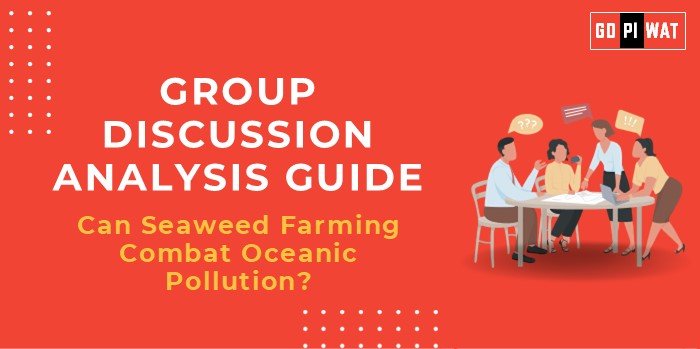📋 Group Discussion Analysis Guide: Can Seaweed Farming Combat Oceanic Pollution?
🌍 Introduction to the Topic
Opening Context: “As the world grapples with escalating marine pollution and dwindling aquatic ecosystems, seaweed farming emerges as a promising, sustainable solution.”
Topic Background: Seaweed farming, historically practiced in Asia, is now gaining global recognition for its potential to sequester carbon, absorb excess nutrients, and reduce plastic pollution. This practice has been revitalized due to the urgent need for sustainable solutions to combat oceanic degradation.
📊 Quick Facts and Key Statistics
- 🌊 Ocean Pollution: Over 8 million tons of plastic enter oceans annually, disrupting ecosystems.
- 🌱 Seaweed Carbon Sequestration: Seaweed captures up to 173 million metric tons of carbon dioxide globally per year.
- 📈 Global Production: Seaweed farming constitutes 97% of global aquaculture plant production.
- ⚡ Nutrient Absorption: Seaweed can reduce 80% of nutrient pollution in aquaculture environments.
- 💰 Economic Potential: Seaweed farming is projected to grow into a $30 billion industry by 2028, creating sustainable livelihoods.
🤝 Stakeholders and Their Roles
- 🏛️ Governments: Establish regulations, fund research, and promote seaweed farming policies.
- 👩🌾 Farmers and Coastal Communities: Implement seaweed farming practices, benefiting from eco-friendly income sources.
- 🌱 Environmental Organizations: Advocate for sustainable practices and monitor pollution reduction.
- 🌐 International Bodies (e.g., UN): Promote seaweed as a nature-based solution to meet global climate and biodiversity goals.
🏆 Achievements and Challenges
✨ Achievements
- 🌊 Nutrient Absorption: Successfully reduced eutrophication in marine environments near seaweed farms in Japan and Norway.
- 🌍 Carbon Sequestration: Contributes to mitigating climate change by storing atmospheric carbon.
- ♻️ Plastic Pollution Alternative: Seaweed bioplastics offer eco-friendly packaging solutions.
⚠️ Challenges
- 📚 Limited Knowledge: Insufficient expertise and technology in non-coastal areas.
- 🌱 Ecological Concerns: Risks of monoculture impacts on marine biodiversity.
- 💰 High Costs: Initial farming equipment and infrastructure costs can be prohibitive.
🌏 Global Comparisons
- 🇰🇷 South Korea: Leads in seaweed farming innovation, providing scalable models for replication.
- 🇮🇳 India: The Gulf of Mannar initiative integrates community welfare and ecological benefits.
🗣️ Structured Arguments for Discussion
- ✅ Supporting Stance: “Seaweed farming can effectively combat oceanic pollution by absorbing excess nutrients and reducing eutrophication.”
- ❌ Opposing Stance: “Scaling seaweed farming globally could disrupt marine biodiversity and may not be economically viable in all regions.”
- ⚖️ Balanced Perspective: “While seaweed farming shows significant promise in reducing oceanic pollution, its environmental and economic feasibility must be carefully assessed.”
🎯 Effective Discussion Approaches
- 📊 Opening Approaches:
- 📈 Data-centric: “Did you know seaweed can reduce oceanic nutrient pollution by 80% while creating economic opportunities?”
- 🌍 Case-study-driven: “The Gulf of Mannar in India demonstrates how seaweed farming benefits both ecosystems and communities.”
- 🔄 Counter-Argument Handling:
- Address monoculture risks by proposing diversified farming practices.
- Highlight economic incentives as a counter to initial costs.
🔍 Strategic Analysis of Strengths and Weaknesses
- 💪 Strengths: High scalability, carbon capture potential, eco-friendly bioplastics.
- 🤔 Weaknesses: Limited geographic feasibility, potential ecological trade-offs.
- 🚀 Opportunities: Expansion in coastal nations, integration with fisheries, climate change mitigation.
- ⚠️ Threats: Overexploitation, market competition, regulatory hurdles.
🎓 Connecting with B-School Applications
- 🌱 Real-World Applications: Sustainability projects, market analysis for seaweed-based industries, and eco-tourism integration.
- 📝 Sample Interview Questions:
- 💬 “How can seaweed farming be a viable alternative to combat ocean pollution?”
- 💬 “Discuss the economic and environmental trade-offs of seaweed farming.”
- 💡 Insights for B-School Students:
- 📊 Opportunity to explore interdisciplinary projects combining sustainability and business.
- ♻️ Relevance to emerging green business trends and ESG metrics.


